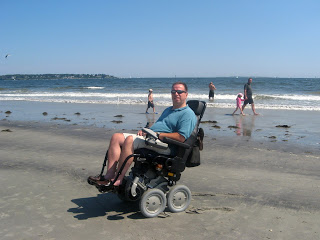Looking Back
I’ve written here countless times about my stairclimbing, four-wheel-drive, balancing-on-two-wheels wheelchair, the
iBOT. Here are a couple of excerpts about the iBOT from my upcoming book “ENJOYING THE RIDE: Two Generations of Tragedy and Triumph.”
There is no relationship between human and machine more intimate than that between a wheelchair and its user. The chair serves not only the function of legs, but also couch, recliner, dining room chair, car seat, chaise lounge, dog walker, coat rack, drink holder, getaway vehicle, and shopping cart. It is, therefore, ironic that the customary term for such a condition is “confined to a wheelchair,” when, in fact, the more accurate term is “empowered by a wheelchair.”
I wrote about taking the iBOT home for the first time, after eight grueling hours of training:
On the drive home Kim and I found ourselves alone with the iBot. Our trainers were no longer there, approving or disapproving of every move. This reminded me of the drive home from the hospital so many years earlier with our first child, wondering if we were ready for the added responsibility, but excited about the future.
I received a letter, six months after purchasing my iBOT, announcing that the program had been discontinued, mostly due to the fact that Medicare would not reimburse patients:
From the time I took delivery of my iBot until the moment I read this letter, I had been an evangelist. Everywhere I went, I spread the good word about this life-changing device. Nobody with a progressive, crippling disease had ever been more delighted than me to obtain a wheelchair, not only because it improved my life, but because I became part of something bigger than myself. I felt proud to be one of several hundred people in the world to own an iBot, and I wanted anyone who needed one to have that same opportunity. Few causes come along in an individual’s life that are this deeply personal, this rewarding, this freaking awesome.
And, poof! It was gone.
That’s where things stood for a few years. A number of us had our iBOTs, but nobody else would.
Looking Forward
The iBOT wheelchair was invented by
Dean Kamen and his company,
DEKA, located in Manchester, New Hampshire. Since the initial effort was shut down, Dean and his team have been working on a new iBOT.
Over the past couple of years, I, and a few other users have met with representatives from DEKA to provide feedback on their updated design. In one phone interview with representatives from DEKA, they asked me a series of questions along the lines of “would I rather have this or would I rather have that” in a wheelchair. Then they asked if I had any other suggestions for the iBOT.
I said, “Yes. I have three more pages. I just emailed them to you. Let’s go over them.” And we did. Each and every one.
Last week was something special, however. Kim and I made the 90-minute drive from South Portland to Manchester, so I could try out one of their prototypes. The new iBOT is a thing of beauty. After driving it for a couple of hours I made a few suggestions, but they were minor because DEKA has this thing well designed.
When they roll out the next generation iBOT, it won’t have many new functions compared to the old iBOT. It’s just that every function has been improved. The seat is more comfortable. The transitions between modes are quicker and smoother. Stairclimbing, balance, and four-wheel-drive work better. The controller and joystick are more ergonomic. The software is more intuitive. The chair is lighter and smarter. And the batteries? No more deep discharge required. Enhancements, such as tilt, recline, leg elevate, and automobile docking will be considered after the initial rollout.
With the redesigned iBOT, Mobius Mobility, a new company in Manchester, NH, is entirely focused on the manufacturing and distribution. Although they have obtained FDA approval, DEKA and Mobius are still working on a Medicare reimbursement strategy, and have confidence they can achieve a much better result this time around.
I wish I could answer questions like how much is it going to cost and when is it going to be available, but I don’t know those things. I do know that I saw lots of very smart people working on iBOTs last week, and these people are motivated to make the iBOT business permanent this time — permanent and better than ever. I can’t wait.
Note: Look for announcements in the coming weeks about the publish date for my book.



Woohoo! Terrific news about the iBOT and your book.
-dB
Thanks Darren!
Thanks Mitch, I can't wait!
it's coming…
Great news on two fronts: the iBOT and your book! I want one (not an iBOT, but the book…). Mine is in last design stages…it won't be long! Maybe we should celebrate our publications with another lunch…
Absolutely, Deb.
Your machine looks and sounds amazing, Mitch. Maybe, when the revived version is available, I can dream of one. I'm living with frustration as the quality powered chair I brought from the UK can't be repaired in the US as it's 'foreign' [German-built].
Roland, oh my goodness, that must make it difficult for you
What great news, Mitch. Thanks for passing it along.
And your suggestions to the company to make it even more user friendly is such a plus for the designers.
I will be watching the Mobius website.
Dee/OH
That is great news. I'm trying to remember what I knew about Toyota and the iBot. Was that the repair of the model you have?